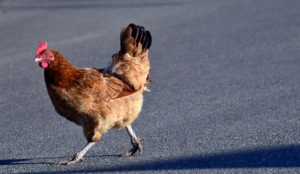On a whim, my husband decided to apply for a job…2400 miles from our current home. For some reason, he was shocked when the company contacted him for an interview. Suddenly, the whim went from “oh well that would be interesting” to “oh crap how are we going to move with 22 chickens, three pregnant goats, one elderly horse, and two dogs?”
In the end, he ended up turning down the job, but before we got to that point, I did a lot of research on moving with chickens. I figure I can’t be the only one staring down a long highway ride with a menagerie of critters, so I thought I would share what I learned.

This chicken is ready to hop in and go!
USDA Regulations
I was well aware my goats and horse would need a veterinary certificate to travel across state lines, but I was a little surprised to learn I would need a certificate for chickens as well. I’m not sure why I was surprised. I have carted plenty of different livestock around the country before, all requiring health certificates, but for some reason, I thought my feathered friends would be different. Eh, wrong.
If your new home is in a different state, be sure to check the USDA regulations and the guidelines of the state you are entering. Some states, like Florida, have an Agricultural checkpoint as soon as you enter the state. Do your research before you leave so you will know what paperwork you need to bring and where you might need to stop to have the paperwork checked.
Methods of Moving
When my chickens were small and just starting to get outside time, I used a small dog crate to cart them around. This too was my plan for hauling the chickens as well. I figured I would stuff them in a few dog crates while they were sleeping. Then put the crates in my horse trailer, hitch up and go. I think this plan would work well, but in the interest of research, I asked the internet. As you might guess, the answers were informative and entertaining.
Most agreed with my dog crate method. Some advised me to make sure I had extra bedding with me so I didn’t stink up the place to bad. Others suggested a mat or newspaper down first to make things smoother should I decide to change bedding. Everyone agreed any opening of the crates should be done at night and in an enclosed area. I thought this was sensible advice. No one wants to chase loose chickens at an interstate rest area.

Image by Ulrike Leone from Pixabay
There were, of course, a few more interesting suggestions. One person “free-ranged” her birds in the car as she drove down the road. As amusing as it sounded at first, several thoughts rammed through my head all at once. “No way my husband is going to let that happen”, “OMG the clean-up!” and “What if a bird starts flapping in your face while you are driving?” were at the top of the list. As I imagined my husband’s face being flogged while driving down the highway, I quickly ditched this suggestion.
The most unique suggestion was to wrap the birds in newspaper and put a rubber band around them to keep them from hurting themselves or anyone else. I imagined myself wrapping my chickens like a Christmas present and giggled. As fun as it might be, I decided my chickens probably wouldn’t appreciate it.
Feeding and Watering While Traveling
Given the shifting nature of cargo while traveling, most people suggested stopping often to offer food and water. Some crates come with small bowls you can attach to the cage door and these could work well for giving your chickens food and water during the trip. Other options are drip waters for guinea pigs or even a small heavy dish. Again, be sure you are in an enclosed area before you open any chicken doors. This might mean trailer doors or the door to your minivan, either way, close before you open.
In the end, we decided to stay put and I am glad for it. Not only would we have had to move our menagerie but the rest of our household contents as well. We haven’t moved in many years and I am sure I would be finding things and chucking them in the trash only to have my husband sneak them back in somewhere. Marie Kondo help!
Michele Cook is a farmer, author, and communications specialist for the National Federation of Press Women. She raises chickens, goats, and vegetables on her small farm in the beautiful Allegheny mountains of Virginia. If she is not outside caring for her farm you can find her curled up in a chair with her nose stuck in a good book. Follow her on her website.












